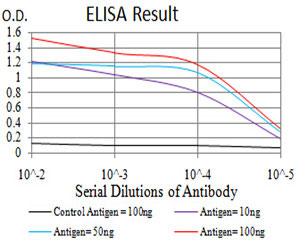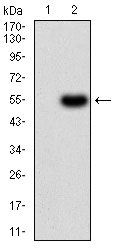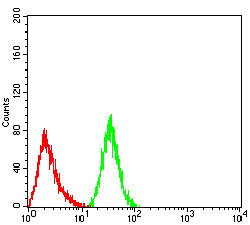PRDM14 Antibody
Purified Mouse Monoclonal Antibody
- 产品详情
- 实验流程
Application
| WB, FC, E |
|---|---|
| Primary Accession | Q9GZV8 |
| Reactivity | Human |
| Host | Mouse |
| Clonality | Monoclonal |
| Clone Names | 6H9F1 |
| Isotype | IgG1 |
| Calculated MW | 64062 Da |
| Description | This gene encodes a member of the PRDI-BF1 and RIZ homology domain containing (PRDM) family of transcriptional regulators. The encoded protein may possess histone methyltransferase activity and plays a critical role in cell pluripotency by suppressing the expression of differentiation marker genes. Expression of this gene may play a role in breast cancer. |
| Immunogen | Purified recombinant fragment of human PRDM14 (AA: 4-203) expressed in E. Coli. |
| Formulation | Purified antibody in PBS with 0.05% sodium azide |
| Gene ID | 63978 |
|---|---|
| Other Names | PR domain zinc finger protein 14, 2.1.1.-, PR domain-containing protein 14, PRDM14 |
| Dilution | WB~~1/500 - 1/2000 FC~~1/200 - 1/400 E~~1/10000 |
| Storage | Maintain refrigerated at 2-8°C for up to 6 months. For long term storage store at -20°C in small aliquots to prevent freeze-thaw cycles. |
| Precautions | PRDM14 Antibody is for research use only and not for use in diagnostic or therapeutic procedures. |
| Name | PRDM14 |
|---|---|
| Function | Transcription factor that has both positive and negative roles on transcription. Required for the maintenance of embryonic stem cell identity and the reacquisition of pluripotency in somatic cells. May play an essential role in germ cell development at 2 levels: the reacquisition of potential pluripotency, including SOX2 up-regulation, and successful epigenetic reprogramming, characterized by EHMT1 repression. Its association with CBFA2T2 is required for the functions in pluripotency and germ cell formation (By similarity). Directly up- regulates the expression of pluripotency gene POU5F1 through its proximal enhancer. Binds to the DNA consensus sequence 5'-GGTC[TC]CTAA- 3'. |
| Cellular Location | Nucleus. |
| Tissue Location | Expressed in embryonic stem cells. Tends to be overexpressed in breast cancer (at protein level) |
Research Areas
For Research Use Only. Not For Use In Diagnostic Procedures.
Application Protocols
Provided below are standard protocols that you may find useful for product applications.
REFERENCES
1.Carcinogenesis. 2014 Nov;35(11):2611-8.2.Med Oncol. 2013;30(3):605.
终于等到您。ABCEPTA(百远生物)抗体产品。
点击下方“我要评价 ”按钮提交您的反馈信息,您的反馈和评价是我们最宝贵的财富之一,
我们将在1-3个工作日内处理您的反馈信息。
如有疑问,联系:0512-88856768 tech-china@abcepta.com.























 癌症的基本特征包括细胞增殖、血管生成、迁移、凋亡逃避机制和细胞永生等。找到癌症发生过程中这些通路的关键标记物和对应的抗体用于检测至关重要。
癌症的基本特征包括细胞增殖、血管生成、迁移、凋亡逃避机制和细胞永生等。找到癌症发生过程中这些通路的关键标记物和对应的抗体用于检测至关重要。 为您推荐一个泛素化位点预测神器——泛素化分析工具,可以为您的蛋白的泛素化位点作出预测和评分。
为您推荐一个泛素化位点预测神器——泛素化分析工具,可以为您的蛋白的泛素化位点作出预测和评分。 细胞自噬受体图形绘图工具为你的蛋白的细胞受体结合位点作出预测和评分,识别结合到自噬通路中的蛋白是非常重要的,便于让我们理解自噬在正常生理、病理过程中的作用,如发育、细胞分化、神经退化性疾病、压力条件下、感染和癌症。
细胞自噬受体图形绘图工具为你的蛋白的细胞受体结合位点作出预测和评分,识别结合到自噬通路中的蛋白是非常重要的,便于让我们理解自噬在正常生理、病理过程中的作用,如发育、细胞分化、神经退化性疾病、压力条件下、感染和癌症。









